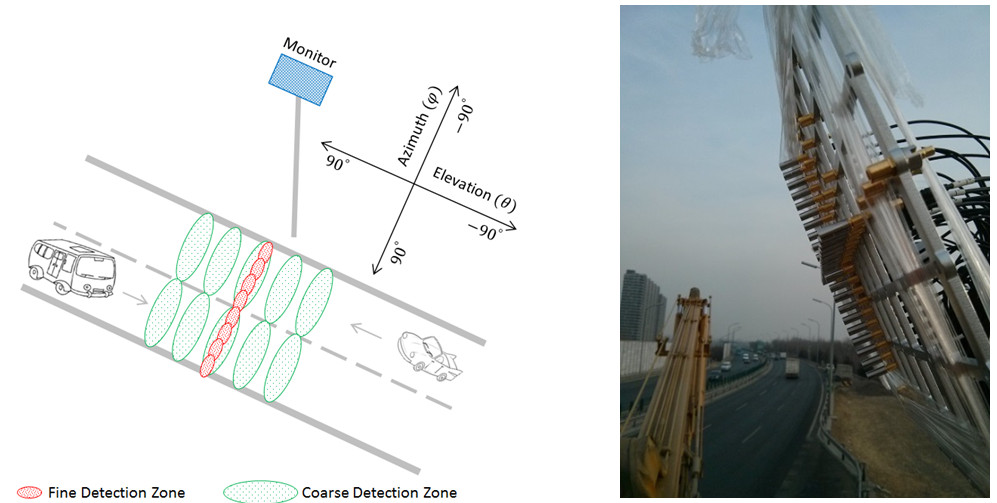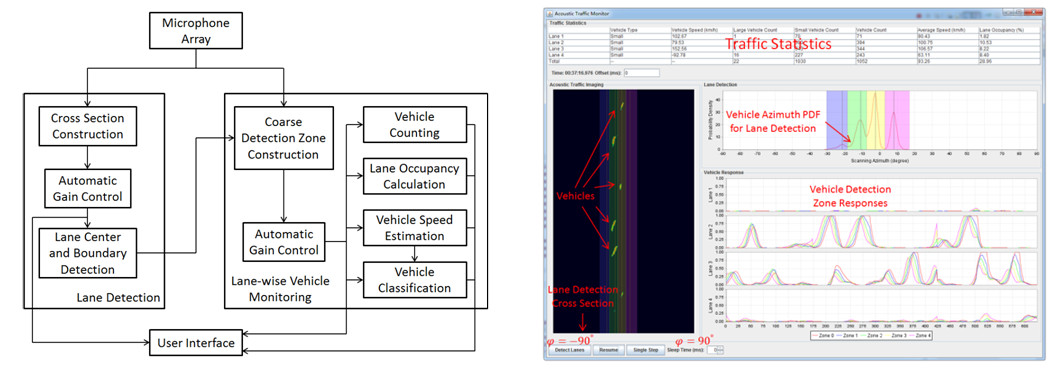Vehicle emits sounds as it travels along the road, which can be used as a kind of feature for traffic monitoring, as depicted in Fig. 1. Compared with other traffic monitoring techniques, acoustic based approach has many advantages.
The acoustic based approach is a nonintrusive technique. It will not cause damage to the pavement. Also, it is a passive monitoring technique, meaning that no harmful radiation will be transmitted to human body. In addition, the hardware cost can be reduced since no signal transmitting device is needed. Besides, acoustic features are very robust against light and weather variations, which is helpful for robust traffic monitoring.

(a) Demonstration of acoustic traffic monitoring. (b) Real-world experimental environment.
Fig. 1 Acoustic traffic monitoring (Image by IOA).
The basic idea of acoustic traffic monitoring is utilizing beamforming techniques to form multiple “detection zones” in different look directions. As shown in Fig.1 (a), fine detection zones are used to detection lanes. They have smaller widths and fixed positions, and multiple fine detection zones are concatenated to form a cross section across the road.
Once a vehicle passes through this cross section, its azimuth will be detected, and lane positions will be estimated from the vehicle azimuth statistics. On the other hand, coarse detection zones are used for lane-wise traffic monitoring. The width of a coarse detection zone covers an entire lane, and each lane is managed by multiple coarse detection zones. Energy responses from coarse detection zones are used to derive different traffic quality measuring indices.
Recently, in order to form vehicle detection zones and perform traffic monitoring, a prototype system is developed by researchers from the Institute of Acoustics (IOA), the Chinese Academy of Sciences. This system comprises of four main modules: microphone array, lane detection module, lane-wise vehicle monitoring module, and user interface. The system block diagram is shown in Fig. 2 (a).
Microphone array is used for data collection and preprocessing. Lane detection module is used to construct fine detection zones and detect lanes. And vehicle monitoring module is used to construct coarse detection zones and derive different traffic indices. At last, user interface is used for data visualization and communication.
Fig. 2 (b) shows the user interface of the developed system. In Fig. 2 (b), the table on the top shows the traffic quality measuring indices for each lane. Four types of indices are derived, including vehicle count, lane occupancy, vehicle speed, and vehicle type (large vs. small). The panel on the left visualizes the acoustic traffic imaging (ATI) of vehicles. The bottom of the ATI is the lane detection cross section, and bright spot means high sound energy, indicating the appearance of a vehicle. The panel on the middle right visualizes the detected lanes, and the panel on the lower right visualizes the responses of individual coarse detection zones. Both simulated and real-world experiments have been carried out, and the experimental results show the efficiency of the developed system.

(a) The system block diagram. (b) The graphical user interface.
Fig. 2 The prototype system (Image by IOA).
Funding for this research came partially from the National Natural Science Foundation of China (Nos. 11461141004, 91120001, 61271426), the Strategic Priority Research Program of the Chinese Academy of Sciences (Grant Nos. XDA06030100, XDA06030500), the National 863 Program (No.2012AA012503) and the CAS Priority Deployment Project (No. KGZD-EW-103-2).
Reference:
NA Yueyue, GUO Yanmeng, FU Qiang, and YAN Yonghong. An Acoustic Traffic Monitoring System: Design and Implementation. The 12th IEEE International Conference on Ubiquitous Intelligence and Computing. August 10-14, 2015, Beijing, China. DOI 10.1109/UIC-ATC-ScalCom-CBDCom-IoP.2015.41
Contact:
NA Yueyue
The Key Laboratory of Speech Acoustics and Content Understanding, Institute of Acoustics, Chinese Academy of Sciences, 100190 Beijing, China
Email: nayueyue@hccl.ioa.ac.cn


